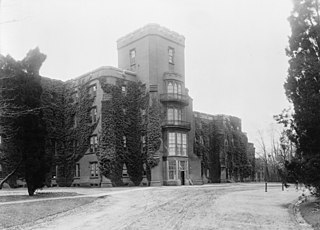
St. Elizabeths Hospital is a psychiatric hospital in Southeast Washington, D.C. operated by the District of Columbia Department of Mental Health. The hospital opened in 1855 under the name Government Hospital for the Insane, the first federally operated psychiatric hospital in the United States.

Pennsylvania Hospital is a private, non-profit, 515-bed teaching hospital located at 800 Spruce Street in Center City Philadelphia, The hospital was founded on May 11, 1751 by Benjamin Franklin and Thomas Bond, and was the second established public hospital but had the first surgical amphitheatre in the United States. and its first medical library. It is part of the University of Pennsylvania Health System.

The Kirkbride Plan was a system of mental asylum design advocated by American psychiatrist Thomas Story Kirkbride (1809–1883) in the mid-19th century. The asylums built in the Kirkbride design, often referred to as Kirkbride Buildings, were constructed during the mid-to-late-19th century in the United States.
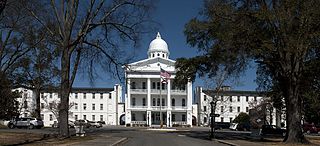
Bryce Hospital opened in 1861 in Tuscaloosa, Alabama, United States. It is Alabama's oldest and largest inpatient psychiatric facility. First known as the Alabama State Hospital for the Insane and later as the Alabama Insane Hospital, the building is considered an architectural model. The hospital houses 268 beds for acute care, treatment and rehabilitation of full-time (committed) patients. The Mary Starke Harper Geriatric Psychiatry Hospital, a separate facility on the same campus, provides an additional 100 beds for inpatient geriatric care. The main facility was added to the National Register of Historic Places in 1977.
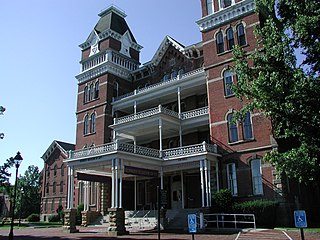
The Athens Lunatic Asylum, now a mixed-use development known as The Ridges, was a Kirkbride Plan mental hospital operated in Athens, Ohio, from 1874 until 1993. During its operation, the hospital provided services to a variety of patients including Civil War veterans, children, and those declared mentally unwell. After a period of disuse the property was redeveloped by the state of Ohio. Today, The Ridges are a part of Ohio University and house the Kennedy Museum of Art as well as an auditorium and many offices, classrooms, and storage facilities.
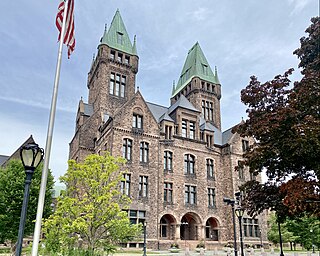
The Richardson Olmsted Campus in Buffalo, New York, United States, was designated a National Historic Landmark in 1986. The site was designed by the American architect Henry Hobson Richardson in concert with the famed landscape team of Frederick Law Olmsted and Calvert Vaux in the late 1800s, incorporating a system of treatment for people with mental illness developed by Dr. Thomas Story Kirkbride known as the Kirkbride Plan. Over the years, as mental health treatment changed and resources were diverted, the buildings and grounds began a slow deterioration. By 1974, the last patients were removed from the historic wards. On June 24, 1986, the former Buffalo State Asylum for the Insane was added to the National Historic Landmark registry. In 2006, the Richardson Center Corporation was formed to restore the buildings.
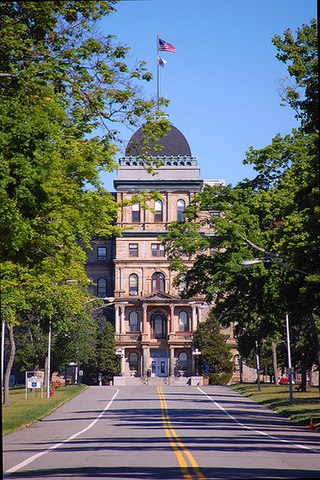
Greystone Park Psychiatric Hospital referred to both the former psychiatric hospital and the historic building that it occupied in Morris Plains, New Jersey. Built in 1876, the facility was built to alleviate overcrowding at the state's only other "lunatic asylum" located in Trenton, New Jersey.

Oregon State Hospital is a public psychiatric hospital in the U.S. state of Oregon, located in the state's capital city of Salem with a smaller satellite campus in Junction City opened in 2014. Founded in 1862 and constructed in the Kirkbride Plan design in 1883, it is the oldest operating psychiatric hospital in the state of Oregon, and one of the oldest continuously operated hospitals on the West Coast.

Harrisburg State Hospital, formerly known from 1851 to 1937 as Pennsylvania State Lunatic Hospital, in Harrisburg, Pennsylvania, was Pennsylvania's first public facility to house the mentally ill and disabled. Its campus is located on Cameron St. and Arsenal Blvd, and operated as a mental hospital until 2006.

Samuel Sloan was a Philadelphia-based architect and best-selling author of architecture books in the mid-19th century. He specialized in Italianate villas and country houses, churches, and institutional buildings. His most famous building—the octagonal mansion "Longwood" in Natchez, Mississippi—is unfinished; construction was abandoned during the American Civil War.

Thomas Story Kirkbride was a physician, alienist, hospital superintendent for the Institute of the Pennsylvania Hospital, and primary founder of the Association of Medical Superintendents of American Institutions for the Insane (AMSAII), the organizational precursor to the American Psychiatric Association. Along with Benjamin Rush he is considered to be the father of the modern American practice of psychiatry as a specific medical discipline. His directive and organization of institutions for the insane were the gold-standard of clinical care in psychiatry throughout the 19th century.

Mendota Mental Health Institute (MMHI) is a public psychiatric hospital in Madison, Wisconsin, United States, operated by the Wisconsin Department of Health Services. The hospital is accredited by the Joint Commission. Portions of the facility are included in the Wisconsin Memorial Hospital Historic District, District #88002183. The Mendota State Hospital Mound Group and Farwell's Point Mound Group are also located at the facility.

The South Carolina State Hospital was a publicly funded state-run psychiatric hospital in Columbia, South Carolina. Founded in 1821 as the South Carolina Lunatic Asylum, it was one of the first public mental hospitals established in the United States. The Mills Building, its first building, was designed by early American architect Robert Mills, and is a National Historic Landmark. The hospital had more than 1,000 patients in 1900, but with the transition of mental health facilities to community settings, it closed in the late 1990s. While buildings on the campus were temporarily used for inpatient services into the early 2000s, they were not part of the State Hospital, but other inpatient facilities of the agency. Several buildings on its campus housed offices and storage facilities of the state's Department of Mental Health until approximately 2014. In October 2014, the Department sold the first parcels of the property into private ownership and received the first sale proceeds. The William S. Hall Psychiatric Institute remained on the campus until 2015, when it moved to a new facility on Department's Northeast Columbia Campus. As of January 2021, 100% of the South Carolina State Hospital property had been transferred to private ownership. Proceeds from the sale of the Bull Street property must be used to benefit patients of the Agency. As of August 2020, the SC Mental Health Commission had authorized the expenditure of $10 million of the proceeds, $6.5 million, for the development of additional community housing for patients.
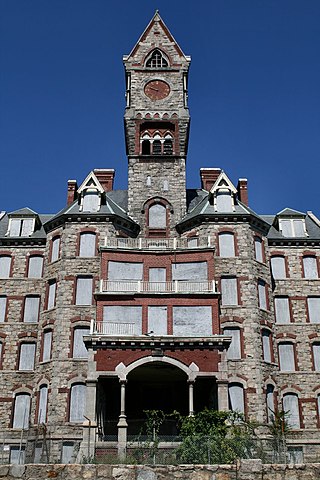
Worcester State Hospital was a Massachusetts state mental hospital located in Worcester, Massachusetts. It is credited to the architectural firm of Weston & Rand. The hospital and surrounding associated historic structures are listed as Worcester Asylum and related buildings on the National Register of Historic Places.

Winnebago Mental Health Institute (WMHI), formerly the Winnebago State Hospital, is a psychiatric hospital near Oshkosh, Wisconsin, United States located in the unincorporated community of Winnebago, Wisconsin.
The Mount Pleasant Mental Health Institute was a psychiatric institution located in Mount Pleasant, Iowa, USA. Originally known as the Iowa Lunatic Asylum, it opened in 1861. It is located on the same campus as The Mount Pleasant Correctional Facility. There was also a labyrinth of tunnels which connected every building. It was the first asylum in Iowa and was built under the Kirkbride Plan.
The Clarinda Treatment Complex was built in 1884 as the Clarinda State Hospital in Clarinda, Iowa in southwest Iowa. It was the third asylum in the state of Iowa. The hospital's many name variations include: The Clarinda Lunatic Asylum, The Clarinda State Asylum, The Clarinda Asylum for the Insane, and The Clarinda Mental Health Institute. It was built under the Kirkbride Plan. The original plan for patients was to hold alcoholics, geriatrics, drug addicts, mentally ill, and the criminally insane. In 2009, it was made public that, to save money, the state may close one of the four hospitals in Iowa. On June 30, 2015, the hospital facility was shut down and all patient services terminated. The Clarinda Academy, owned by Sequel Youth Services, is the sole occupant of the former hospital grounds.
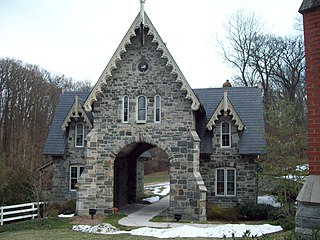
The Sheppard and Enoch Pratt Hospital, known to many simply as Sheppard Pratt, is a psychiatric hospital located in Towson, a northern suburb of Baltimore, Maryland. Founded in 1853, it is one of the oldest private psychiatric hospitals in the nation. Its original buildings, designed by architect Calvert Vaux, and its Gothic gatehouse, built in 1860 to a design by Thomas and James Dixon, were designated a National Historic Landmark in 1971.

The Dorothea Dix Psychiatric Center is a psychiatric hospital operated by the state of Maine. It is located at 656 State Street in Bangor, and was previously known as the Eastern Maine Insane Asylum and the Bangor Mental Health Institute. It was established in 1895, and the main building on its campus is listed on the National Register of Historic Places.

The Maine Insane Hospital, later the Augusta Mental Health Institute (AMHI), was a psychiatric hospital in Augusta, Maine. It was the principal facility for the care and treatment of Maine's mentally ill from 1840 to 2004, and its surviving buildings represent the oldest surviving complex of mental care facilities in the United States. The complex is located on the east bank of the Kennebec River, immediately south of the former Kennebec Arsenal, and now primarily houses state offices. In 2004, the hospital was replaced by the Riverview Psychiatric Center, located just to the south. The hospital's core complex was listed on the National Register of Historic Places in 1982, with the listing enlarged to encompass the entire campus in 2001.





















